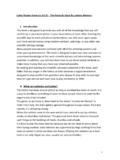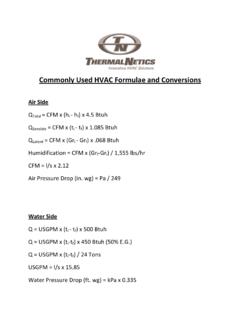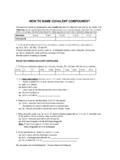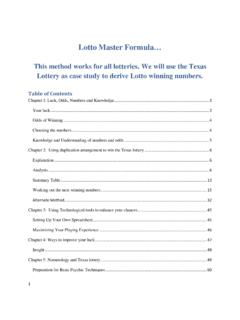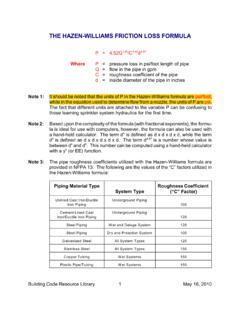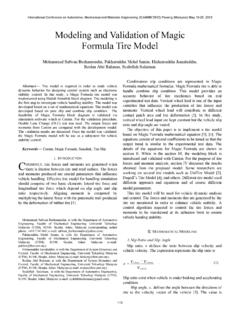Transcription of Formula Masking #1 - AudSim
1 1 Formula Masking #1 A Review of General Masking Concepts and the Masking Plateau 2 Overview Mastery of plateau Masking is important Sometimes you cannot plateau Speech discrim testing ABR testing Sometimes it is more efficient to Formula Masking Time savings in any busy practice Limited test time (children) Sometimes you will want to revert to plateau Masking if at all possible Too many unknowns, too complicated, too great a chance for errors. (Conductive loss bilat or to NTE) 3 Masking Fundamentals All crossover happens by bone conduction, even if the stimuli are presented by air conduction. 4 Interaural Attenuation The loss of sound intensity as it goes from one ear to the NTE COCHLEA. Depends upon Frequency Transducer Individual skull characteristics Since we don t know who has a thick skull we assume the worst case scenario.
2 Assume minimal IA. 5 Interaural attentuation values 40 is the commonly used minimum IA value for TDH/MX41AR It is probably a bit conservative. 45 is probably appropriate, with a median IA of 60. However, tradition dictates using 40. Deeply inserted insert phones give 15-20 more IA. Viewing the next two figures, what minimum IA value will you use? 6 Comparison of Interaural Attenuation Values01020304050607080902505001k2k3k4k6 kFrequencydB IASupra-auralInsert earphonesMinimum Values, per Sklare & Denenberg, 1987 7 Min. IA Munro & Agnew (1999)010203040506070802505001k2k3k4k8kF requencyIA MinimumsSupra-auralInsert - deepInsert - shallow8 Yacullo From Katz 6th edition From the EARTone manual 9 10 Opinions vary What do you plan to do? Mask whenever 40/50 rules met Use Yacullo s rule: 50 in high freq, 75 at 1k and below Have a frequency-specific chart of IA values per transducer Pros Cons 11 Speech & click IA When testing w/ a wide-band signal (speech, click) some say use the same minimum IA you don t know which frequency is crossing over & heard.
3 However, clicks and speech are wide-band signals, meaning less energy at any single frequency region, and appear to have greater IAs. Supraaural earphones, 50 is a good minimum number; 60 for inserts. You can be more conservative if desired. 12 Next big point Occlusion Effect BONE CONDUCTED sound is enhanced when the NTE is covered. The three mechanisms for BC are: Compression / distortion of cochlea shell Inertial lag of stapes in oval window BONE CONDUCTION BY AIR CONDUCTION 13 Covering NTE enhances the BC signal 14 don t cover NTE unless you are going to mask If you put oscillator on the left ear, and an insert in the right ear, the unmasked threshold (dotted line in illustration) is artificially lowered by the amount of the occlusion effect for that person/ear. Bone will be better than it would be without Masking .
4 Right ear is NTE and has normal hearing. The occluded, unmasked threshold is RE w/ OE. 15 If you record an unmasked symbol, it is inappropriate to have used contralateral you are not communicating the results in a way that lends itself to replication of findings. 16 My bad! 84 year old male. Tymps normal. Reflexes present probe right, ipsi & contra, but I couldn t get a seal on very elliptical ear canals left side. Tested the patient w/o a student. 17 18 1st patient of the day. What s wrong with this picture? Obviously my brain was on holiday before my body; what is my mistake? Masking levels: 60 / 70 / 60 / 60 / 70 at 250-4k respectively. 19 Too bad I couldn t get reflexes on the left ear! Anything else occlusion effect wise that could help us figure out if left really has a conductive loss? Masking levels 75/70/60/60/70 20 Another note on occlusion If there is a conductive loss in the NTE, then the extra AC by BC is not likely to help hearing the sound from the BC by AC mechanism is attenuated by the conductive loss; the other BC mechanisms predominate.
5 If there is a outer ear conductive, eg plug of wax, then you might already have an OE. 21 Next topic. My term: safety pad When you start plateau Masking for AC, you don t start w/ the noise right at threshold, you start at 10 (?) above, right? And for bone, you start at the OE plus this pad The rule Bone 25/25/20 comes from OE (15/10) + pad (10) you can omit OE If you know that the ear has a conductive loss ( flat tymps and absent reflexes bilaterally), you could omit the occlusion effect from the Formula you use for Masking . 22 23 When plateau ing .. What if there is a small air-bone gap were at just one frequency, would you not add the OE just at that one frequency? Probably should use OE even at that one frequency. It s likely a fluke that there is an ABG, so be conservative and add OE in. (More to come.)
6 In Formula Masking , you ll hear that you add into the calculation the larger of OE or ABG which I only mention here so that when you study for the test this slide doesn t confuse you.) 24 Masking Assignment One Measure a friend s hearing Forehead bone unmasked: 250 4k Hz. Use forehead symbol Better ear (if there is one) bone unoccluded: 250 4k Hz. Typical symbol. Same ear bone with NTE occlusion with insert earphone. Retest, mark >O Each ear air conduction unmasked Do not stop at zero, establish threshold in the negative # range 25 Record using table below & submit with your name & initials of your subject 250 500 1k 2k 4k Forehead UnOcc NTE Occ Right Air Left Air Remember go below zero with thresholds! 26 VT threshold limits 250 500 1k 2k 4k Mastoid Fingers Ankle bone -medial 27 Why??? We will examine How much shift came from occluding?
7 Is forehead equal to mastoid? Are we seeing routine air bone gaps? What is a low end & a realistic VT threshold? Ankle bone exploratory; test of peripheral neuropathy 28 Bergin et al 1995 250 Hz results BC = audiometer 29 Occlusion effects minimized by insert earphones, too While supra-aural earphone OEs were 250 500 1k 21 18 3 Insert earphone values were: 250 500 1k 17 12 3 Average of deep/shallow insertion, AJA (2000) p 132. Less area of ear canal to vibrate w/ insert earphones We will use the more traditional 250 500 1k 15 15 10 With 10-15 safety pad you are OK if the person s OE is bigger than average 30 What size OE for this patient? 15 / 5 / 15 / 5 / 5 so my patient isn t average 31 If it s critical, you can measure the OE size Just as I did in my error, test w/ ear unoccluded.
8 Retest occluded w/o Masking . The difference is the OE. You could add that value when Masking rather than estimating. Fortunately it s seldom that critical! 32 Defining Effective Masking EM definition if Masking noise of that level is in the ear, and the tone is put into the same ear at equal in intensity, you have masked. 50 dB EM masks 50 dB PT in SAME ear. So, if crossed if the tone crosses over at 10 dB HL, theoretically, putting in 10 dB EM in NTE, that would be enough (if there is no conductive loss to reduce the level at the cochlea.) Padding adds a safety factor ( the IA is a little lower or OE bigger than you think, or if the calibration is a little off.) 33 Where are you in your thoughts on Masking ? Some really thinking clicker 34 Q #1. If a signal crosses over, think about whether it could be heard by examining the relationship of the crossed-over signal 50%50% air conduction threshold bone conduction threshold 35 Masking noise is put into the 25%25%25%25% ear by air conduction ear by bone conduction ear by air conduction ear by bone conduction 36 Over Masking occurs 50%50% Masking noise prevents the TE from hearing the signal Masking noise prevents the NTE from hearing the signal 37 Over Masking is a problem when 50%50% NTE noise crosses over by air conduction NTE crosses over by bone conduction 38 Is the interaural attenuation the same for air-conducted tones and for air-conducted NBN Masking ?
9 50%50% 39 Plateau Review If Masking is needed, begin with the NTE threshold + OE if testing bone + safety pad. AC. Testing right, put 20-25 EM left (threshold plus your 10 or 15 pad) 40 Assume the unmasked R threshold was due to crossover heard by left bone. Now the left ear has 25 dB of Masking noise and will not hear the crossed over pure tone. The threshold will shift. How much? Can a 70 dB tone be heard? (next slide) 41 70 can t be heard, 75 can t be heard, But 80, yes! 42 Plateau steps Increase the Masking in 5 dB increments until you have at least 3 increases (15 dB plateau) with no change in threshold. (I am going to raise the noise 10 for a few slides to speed things along.) 43 Undermasking 44 Noise up 10 more 45 46 47 Clinical speed tip The traditional Masking technique is to increase the noise in 5 dB steps for three sequential times.
10 No threshold shift = plateau. Why not increase noise by 15 dB? If there is no shift, you are done! Faster! If there is a shift, then just go back to the 5 dB way of doing it and find the plateau. Dixi running in flooded back yard 48 49 Speed tip expanded In simple cases such as this unilateral SNHL, the plateau is wide. The hint of go up 15 dB with your Masking noise will work well. Lead in to Formula Masking . If I think it s a case like this, where the real plateau is wide, then I will be selecting a noise level that should put me well on the plateau. I put in that noise, find the threshold. I do some checking to see if all is well. If so, there is no increasing the noise level and re-measuring threshold. Done! Formula Masking does not use sequential noise adjustments so it is even faster than the up 15 & check if you have estimated the range of the real threshold correctly.
